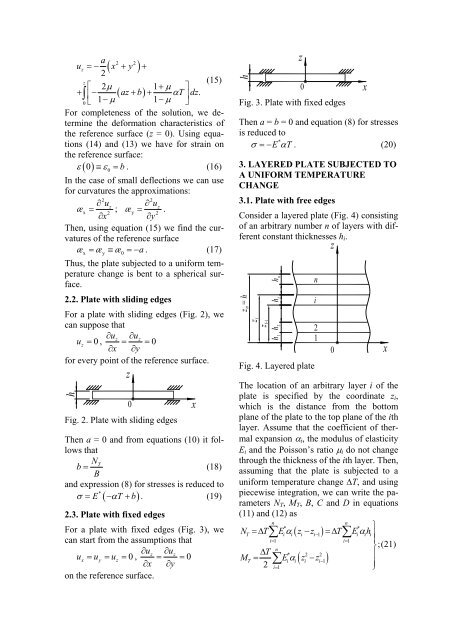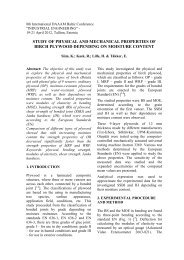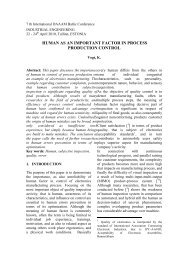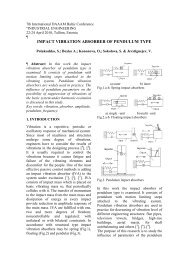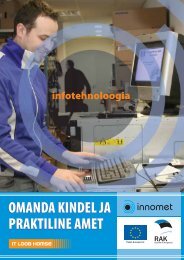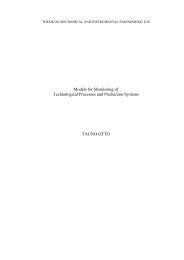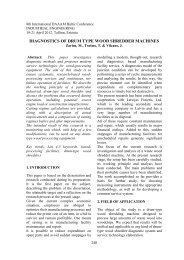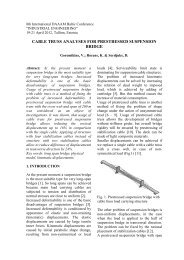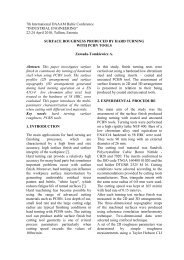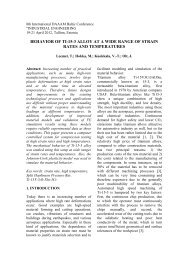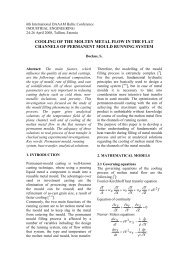ANALYSIS OF THERMOELASTIC STRESSES IN LAYERED PLATES
ANALYSIS OF THERMOELASTIC STRESSES IN LAYERED PLATES
ANALYSIS OF THERMOELASTIC STRESSES IN LAYERED PLATES
You also want an ePaper? Increase the reach of your titles
YUMPU automatically turns print PDFs into web optimized ePapers that Google loves.
a 2 2uz=− ( x + y ) +2z(15)⎡ 2μ1+μ ⎤+ ∫ ⎢− ( az + b)+ α T .1−1−⎥dz0 ⎣ μμ ⎦For completeness of the solution, we determinethe deformation characteristics ofthe reference surface (z = 0). Using equations(14) and (13) we have for strain onthe reference surface:ε( 0) ≡ ε0=b . (16)In the case of small deflections we can usefor curvatures the approximations:22∂ uz∂ uzæx = ; æ ∂2 y= .2x ∂ yThen, using equation (15) we find the curvaturesof the reference surfaceæx = æy ≡ æ0=−a. (17)Thus, the plate subjected to a uniform temperaturechange is bent to a spherical surface.2.2. Plate with sliding edgesFor a plate with sliding edges (Fig. 2), wecan suppose that∂uz∂uzuz= 0 , = = 0∂x∂yfor every point of the reference surface.Fig. 2. Plate with sliding edgesThen a = 0 and from equations (10) it followsthatNb = T(18)Band expression (8) for stresses is reduced to*σ = E − α T + b . (19)( )2.3. Plate with fixed edgesFor a plate with fixed edges (Fig. 3), wecan start from the assumptions that∂uz∂uzux = uy = uz=0 , = = 0∂x∂yon the reference surface.Fig. 3. Plate with fixed edgesThen a = b = 0 and equation (8) for stressesis reduced to*σ =−E α T . (20)3. <strong>LAYERED</strong> PLATE SUBJECTED TOA UNIFORM TEMPERATURECHANGE3.1. Plate with free edgesConsider a layered plate (Fig. 4) consistingof an arbitrary number n of layers with differentconstant thicknesses h i .Fig. 4. Layered plateThe location of an arbitrary layer i of theplate is specified by the coordinate z i ,which is the distance from the bottomplane of the plate to the top plane of the ithlayer. Assume that the coefficient of thermalexpansion α i , the modulus of elasticityE i and the Poisson’s ratio μ i do not changethrough the thickness of the ith layer. Then,assuming that the plate is subjected to auniform temperature change ΔT, and usingpiecewise integration, we can write the parametersN T , M T , B, C and D in equations(11) and (12) asnn* * ⎫NT =ΔT∑Eiαi( zi− zi−1)=ΔT∑Eiαihi⎪ i= 1 i=1 ⎪⎬;(21)nΔT* 2 2M = ( −−1)⎪T ∑Eiαizi zi2 i=1⎪⎭


